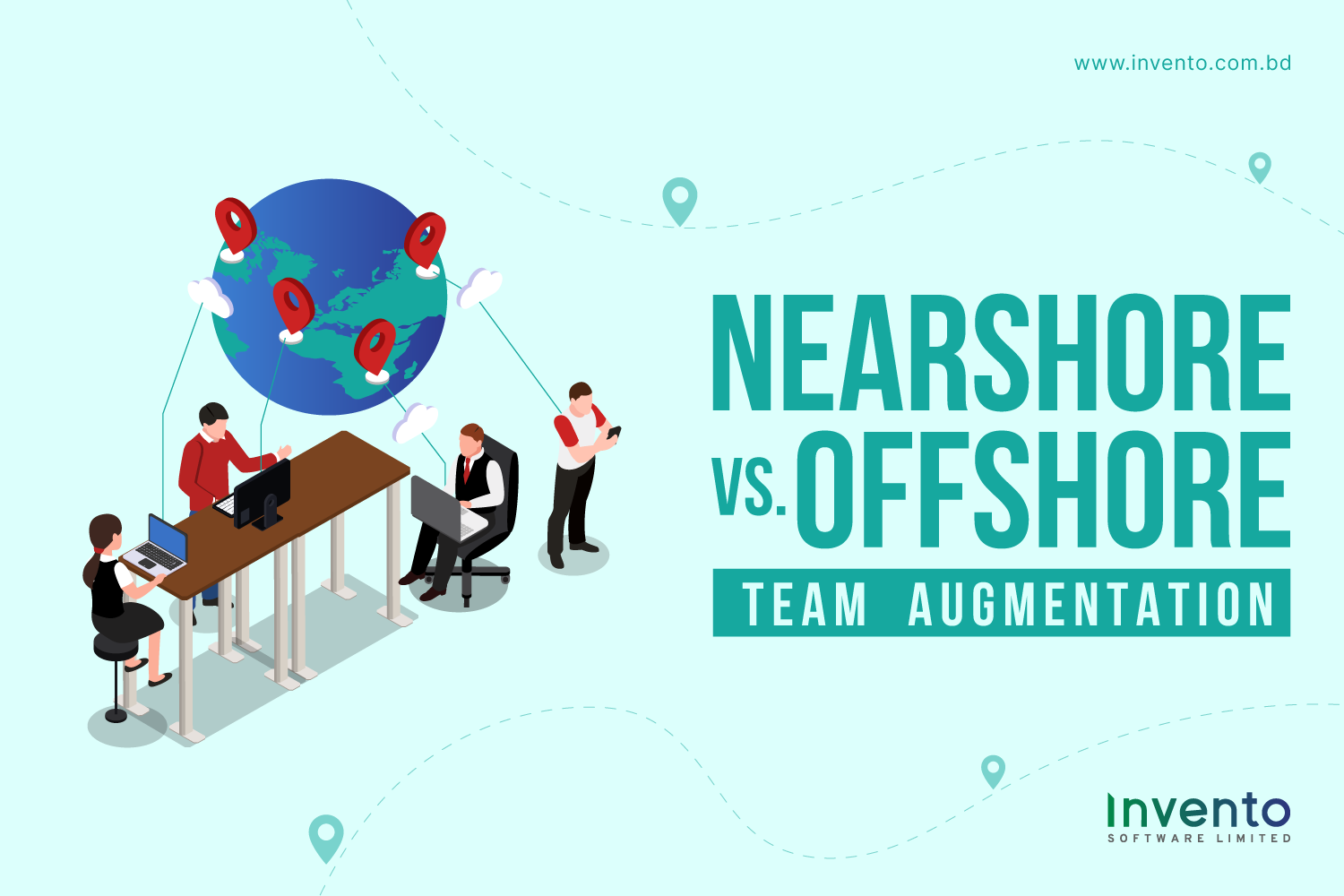The demand for technology talent is growing every single day. Companies across industries, from startups to large enterprises, are accelerating digital transformation projects, moving to the cloud, adopting ERP systems, and integrating AI-driven solutions. However, the global shortage of skilled IT professionals continues to widen.
Finding the right people with the right expertise at the right time has become increasingly difficult. Add budget pressures, short delivery timelines, and fierce competition for qualified developers, and you’ll see why many organizations are turning to staff augmentation as a smart and scalable solution.
Outsourcing no longer means handing over full control to an external vendor. Today, it’s about collaboration, flexibility, and access to specialized talent. Within this context, two models often stand out: nearshore and offshore IT staff augmentation.
Choosing between these two models can significantly impact your project’s cost, quality, and delivery speed. In this article, we’ll dive deep into what each model means, how they differ, and how to decide which one is right for your business.
What Is IT Staff Augmentation?
IT staff augmentation is a flexible hiring strategy that allows organizations to bring in external technology professionals to work alongside their in-house teams for a specific period.
This model is particularly useful when a project requires specialized skills but not a full-time permanent hire. It helps organizations quickly plug skill gaps without the overhead of recruitment, training, or long-term employment costs.
In short, you get the right talent, at the right time, for the right duration, all under your direct supervision.
Nearshore IT Staff Augmentation
Nearshore staff augmentation involves hiring IT professionals from neighboring or nearby countries, typically sharing similar time zones and cultural backgrounds.
For example, a company in Canada might hire developers from Mexico or Costa Rica. Similarly, an organization in Germany might work with teams in Poland, Romania, or the Czech Republic.
Because the distance is short and the time zone overlap is strong, nearshore professionals can easily integrate into your existing team structure and work almost in real time.
Key Benefits of Nearshore IT Staff Augmentation
- Real-Time Collaboration
Communication is smooth because nearshore teams share overlapping work hours. Meetings, standups, and project syncs can happen seamlessly without scheduling challenges.
- Cultural Alignment
Shared cultural traits and language familiarity reduce misunderstandings. This makes team bonding and collaboration more natural.
- Ease of Travel
If in-person meetings, workshops, or training sessions are required, nearshore locations make travel simple and cost-effective.
- Faster Integration
Onboarding and collaboration tend to be faster, as fewer barriers exist in time, culture, or communication.
- Operational Flexibility
Nearshore staff act as an extension of your in-house team, giving you the benefits of outsourcing with the feel of an internal team.
Potential Drawbacks
- Costs are higher than offshore, though still lower than local hiring.
- Talent availability can be regionally limited, depending on your technology stack and project requirements.
Offshore IT Staff Augmentation
Offshore IT staff augmentation involves working with professionals or teams from countries farther away, often in very different time zones.
For instance, a US-based company may hire software engineers from India, Bangladesh, or the Philippines; a UK company may work with teams in Vietnam or Malaysia.
This model focuses on cost savings, scalability, and global reach, often providing access to a much larger and more diverse talent pool.
Key Benefits of Offshore IT Staff Augmentation
- Significant Cost Savings
Offshore talent usually offers more affordable rates without sacrificing technical capability, helping companies achieve better ROI.
- Larger Talent Pool
Access a broader range of skills from niche technologies to large development teams that may not be available locally.
- Round-the-Clock Productivity
Different time zones can be an advantage, enabling 24/7 progress on projects. One team can continue development while the other sleeps.
- Scalability and Flexibility
Offshore augmentation makes it easy to ramp up or scale down teams based on project demand.
Potential Drawbacks
- Time zone differences can cause communication delays.
- Cultural gaps may lead to misunderstandings.
- Quality control requires strong project management and documentation.
Offshore teams work best when communication is structured, requirements are clear, and collaboration tools are used effectively.
Nearshore vs Offshore IT Staff Augmentation: Key Differences
| Factor | Nearshore IT Staff Augmentation | Offshore IT Staff Augmentation |
| Geographic Proximity | Nearby or neighboring countries | Distant countries across continents |
| Time Zone Overlap | High | Low |
| Cultural Compatibility | Strong | Varies |
| Cost | Moderate | Lower |
| Talent Pool | Limited regionally | Very large globally |
| Communication | Real-time and easy | Asynchronous and delayed |
| Project Suitability | Agile, collaborative projects | Large-scale, well-defined projects |
| Onboarding Speed | Fast | Slower due to distance |
| Risk Management | Low | Higher if unmanaged |
| Legal Compliance | Easier | Varies by country |
Comparing the Benefits
| Category | Nearshore | Offshore |
| Communication | Seamless and real-time | Requires coordination and tools |
| Cost Efficiency | Balanced savings | Maximum savings |
| Collaboration | Tight integration | Ideal for independent work |
| Talent Access | Regional experts | Global, diverse skill sets |
| Project Management | Agile and responsive | Best for structured, long-term projects |
| Control | High control | Requires process maturity |
| Risk | Lower | Higher if unmanaged properly |
Factors to Consider Before Choosing
1. Time Zone and Proximity
For teams that rely on constant feedback or frequent iterations, nearshore is ideal. Offshore works best when you can plan around asynchronous collaboration and flexible timelines.
2. Cultural Fit and Communication
Similar work ethics, communication styles, and holidays improve synergy. If cross-cultural management isn’t your strength, nearshore may reduce friction.
3. Budget Constraints
If cost reduction is your top priority, offshore delivers more savings. Nearshore, however, often yields better value for money through efficient collaboration.
4. Project Complexity
Complex, evolving projects benefit from nearshore collaboration. Offshore is better suited for defined, long-term engagements.
5. Talent Availability
If you need specific or rare technical skills, offshore might give you access to a wider talent base.
6. Legal and Compliance
Neighboring regions may share similar regulations, making contracts and data protection easier to manage.
7. Risk Management
Distance and legal diversity can introduce risks especially in offshore models. Mitigate them through clear SLAs, NDAs, and IP protection policies.
Best Practices for a Successful Staff Augmentation Partnership
1. Choose the Right Partner
Your success depends on your vendor’s reliability. Pick a partner like Invento Software Limited that has proven experience, strong technical vetting processes, and transparent communication models.
2. Focus on Collaboration and Communication
Establish clear channels (Slack, Teams, Jira) and schedule consistent check-ins. Encourage open dialogue and feedback to maintain momentum.
3. Prioritize Onboarding and Culture
Treat external team members as part of your organization. Share your mission, workflow, and goals so they understand your vision.
4. Maintain Control Over Selection
Always interview and approve candidates. Ensure their skills and mindset fit your team’s culture.
5. Secure Data and Intellectual Property
Partner with companies that follow global standards like ISO 27001 and GDPR compliance. Use contracts that clearly define IP ownership.
6. Set Clear KPIs
Define measurable outcomes for performance, such as sprint velocity, code quality, or issue resolution time.
7. Invest in Relationship Building
Even if the team is remote, show appreciation, celebrate milestones, and maintain consistent engagement. Retention of augmented staff boosts overall productivity.
How Invento Software Limited Works
At Invento Software Limited, we believe staff augmentation isn’t just about filling gaps. It’s about creating synergy.
We support clients globally in building nearshore and offshore teams for ERPNext development, custom web solutions, AI integration, and IoT innovation. Our model ensures:
- Rigorous vetting of technical skills.
- Time zone-optimized collaboration structures.
- Clear onboarding frameworks for quick alignment.
- Continuous support and transparent reporting.
Whether you need two engineers for a six-month sprint or a full remote team for a multi-year product roadmap, Invento helps you scale confidently and efficiently.
Final Word
Both nearshore and offshore IT staff augmentation have their own strengths. The right choice depends on your organization’s priorities. Whether it’s cost optimization, collaboration intensity, or speed of delivery.
- Choose nearshore for tighter integration, easier communication, and real-time collaboration.
- Choose offshore for wider talent access, 24/7 productivity, and maximum cost efficiency.
No matter which model you choose, success lies in choosing the right partner one who aligns with your culture, values, and long-term strategy.
At Invento Software Limited, we help businesses worldwide find the perfect balance between cost, communication, and quality through both nearshore and offshore staff augmentation.
We don’t just extend your team but empower your innovation.
FAQs
1. What is the difference between nearshore and offshore IT staff augmentation?
Nearshore involves hiring professionals from nearby countries with similar time zones. Offshore involves teams from distant regions with different time zones but at lower costs.
2. Which is better for agile projects?
Nearshore augmentation fits agile projects that rely on daily collaboration and fast feedback loops.
3. Can offshore teams work efficiently despite time differences?
Yes, with strong project management, asynchronous communication, and well-defined overlaps, offshore teams can be highly productive.
4. What are the key benefits of nearshore IT staff augmentation?
Cultural alignment, real-time collaboration, and smoother communication are its strongest benefits.
5. How does Invento Software Limited help with staff augmentation?
Invento helps companies assess needs, select the right model, and onboard skilled developers for nearshore or offshore projects ensuring transparent management and consistent performance.







